#sexism in science
Explore tagged Tumblr posts
Note
Fellow AFAB nonbinary: In my day job (an office setting, I'm not out as nonbinary), I've gotten overlooked by the men there -constantly.- I did not go back to school, get a master's IT, put myself in massive debt, and take a job that pays less than what I'm worth JUST FOR MY RELEVANT COMMENTARY TO BE GLOSSED OVER IN YOUR ZOOM CALL, MICHAEL
For REAL
like if someone decides you're a woman, they're not going to listen to you, even if you aren't actually a woman
if someone decides you're a man, you're much more likely to be listened to, even if you aren't actually a man
and I am t i r e d
99 notes
·
View notes
Text
I am officially a cited expert on the history of vaginal anatomy studies! Look mom! I did it!
Okay so here's the story. Way back in ye olde 2014 I was commissioned by The Sweethome (now Wirecutter) to review tampons. As part of my research for that review, I stumbled across some really fascinating old research on vaginal shapes. I wrote about that research for a group blog I used to be a part of, and about the weird little obsession I developed with some long lost research.
All I could really dig up was a set of studies done in the late 1990’s and early 2000’s by a woman named Paula Pendergrass. Pendergrass published a handful of studies about the shape of the vagina, which she measured by doing plaster casts of willing women. And what she described in her work was actually a set of different vagina shapes: the conical, the parallel sides, the heart, the pumpkin seed, and the least fortunately named slug.
But the thing that surprised me most was that after this one small set of studies by Pendergrass, that's it. There was nothing more. And it's not like Pendergrass had answered the question definitively, her work is full of ideas for how to better measure these shapes, and suggestions to collect more data. Why wasn't there anything else here? Why hadn't she continued this work? Why hadn't anybody asked more questions? I needed to know! So I managed to track her down and cold call her house in Arkansas (because journalists like me have no shame) to ask her why she stopped measuring vagina shapes.
Here's what I learned:
There’s no market for this data. Companies that manufacture vaginal products are looking only to confirm that things like tampons fit inside. They don’t care much about the specifics beyond that. But the big reason she highlighted was the one that made me both sad and angry. When she was doing the work, people were grossed out by it. “It’s off-putting to a lot of people, and I’ve had trouble with it since I started,” she said. “People who were embarrassed I was doing this, They said I was a a dirty old woman doing this.” A dirty old woman. For wanting to know the shape and size of the human vagina.
I wanted to chase this story further, but I could never sell it. In part because it's unclear if it matters clinically what the shape of someone's vaginal canal is. And yet... it's just so... INTERESTING!
But I let it go, after that blog post. (Well, that's not entirely true, I actually ordered a dental casting kit and had plans to cast my own vaginal canal using her study's instructions. But I never got around to it.)
FLASH FORWARD TO TODAY. And I get an email from a friend named Perrin Ireland who is apparently helping someone with a book about vaginas. Did I know that my blog was cited in a scientific journal, she asked? No! I DID NOT!!!
But here it is! Gender Bias in the Study of Genital Evolution: Females Continue to Receive Less Attention than Males, Integrative and Comparative Biology, Volume 62, Issue 3, September 2022, Pages 533–541. The author, Dara Orbach, writes:
When Pendergrass et al. (1996) demonstrated that human females have differently shaped vaginas, their findings were “offputting”, Pendergrass reported being called “a dirty old woman”, and gynecologists did not recognize the value of the research (Evelith, 2016). While a national research center exists in theUnited States ofAmerica for most major organ systems (e.g., National Eye Institute), female reproductive anatomy is categorized under the umbrella of the National Institute of Child Health and Human Development. The research environment and social taboos have historically and still continue to hinder scientific inquiry in the field of female genital evolution.
Is my name spelled incorrectly? Yes! Do I care? No!
But truly it's nice to know that even though I couldn't chase this story and really report it out fully, it seems to have made some dent on at least one person who is asking questions about why we don't know more about the internal anatomy of people with vaginas.
If you like this, you'll also enjoy reading the one about how I spent weeks trying to build a replica vaginal canal in my kitchen to test menstrual cups on.
#science#science reporting#reproductive science#sexism in science#citations#my name is spelled wrong but that's fine#vaginal canal#vaginal casting#resurrected vaginal science
15 notes
·
View notes
Text
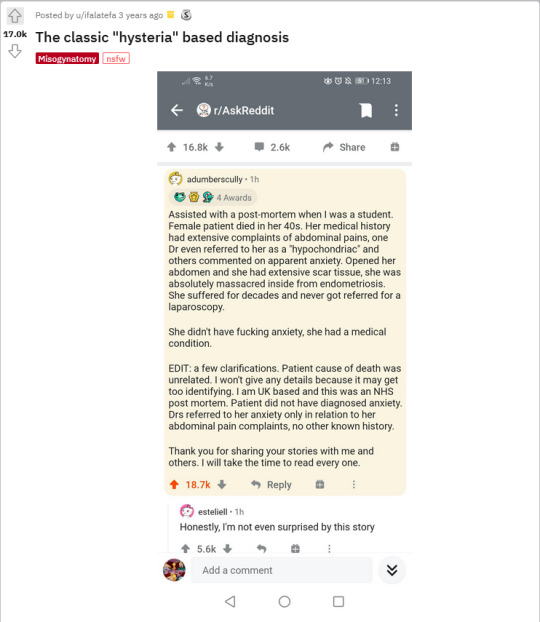
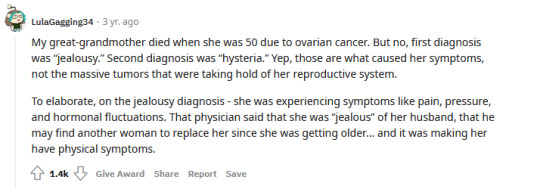
Whenever someone tells you that misogyny, "isn't a big deal", just show them something like this. Post like this are everywhere because this shit is so common. Misogyny kills women. If you wanna see the original thread, here:
ps- Fuck Freud
#the real female hysteria#female hysteria#feminist#feminism#medical malpractice#dr malpractice#malpractice#sexism in science#tw freud#womanism#womanist#medical misogyny
10 notes
·
View notes
Photo
So the girls can read the Ben Barres article.

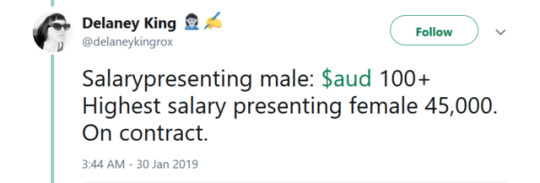



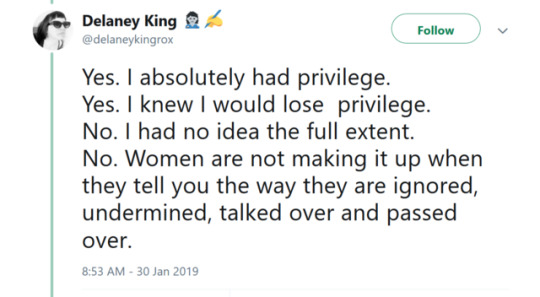

https://twitter.com/delaneykingrox/status/1090402436995473408
179K notes
·
View notes
Text
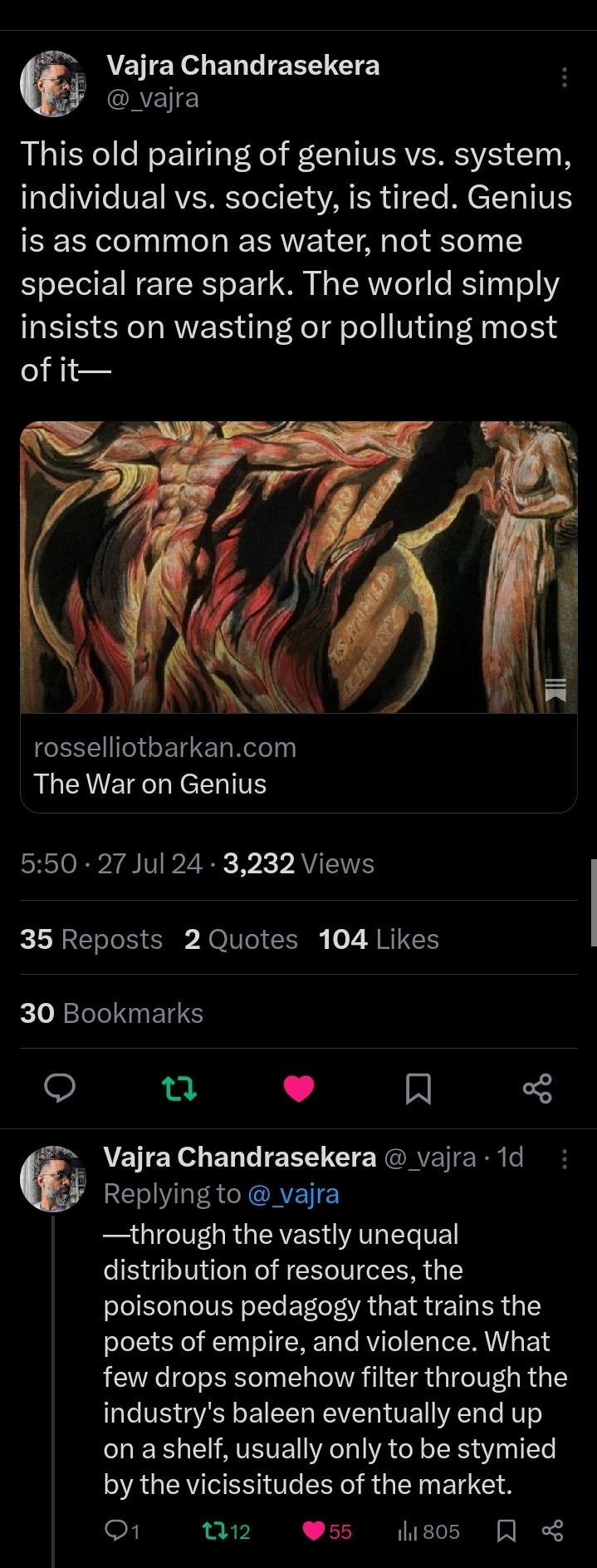


Vajra Chandrasekera is a Locus and Nebula award-winner and has been short-listed for a Hugo Award this year. You can find his Tumblr here: @adamantine and his twitter here: @_vajra
#capitalism#ableism#sexism#anti blackness#colonialism#racism#colonial capitalism#colonial violence#imperialism#poverty#global south#elitism#classism#western imperialism#colonization#gaza writes back#vajra chandrasekera#saint of bright doors#rakesfall#science fiction#genius#art#writing#literature#social justice#individualism#twitter thread#knee of huss#inequality#misogyny
5K notes
·
View notes
Text
Terfs really have no brain cells huh
“Intersex does not exist”????

Anyway:
From Ask A Biologist:

From Planned Parenthood:

https://www.plannedparenthood.org/learn/gender-identity/sex-gender-identity/whats-intersex
From the Intersex Society of North America:

TERFS/RADFEMS STOP BEING IGNORANT SHITS CHALLENGE LEVEL IMPOSSIBLE
#i mean jesus christ#yall are literally denying science in a way that would shock even republicans#I mean it’s not that surprising. radfems and republicans have plenty in common#btw it’s literally none of your fucking businesses if imane is intersex or not#she apparently does not identify as intersex and pressuring her to reveal personal details about her body is uh. really fucking gross??!!#imane khelif#misogyny#sexism#bigotry#transphobia#intersex#intersexism#medical#medical care#healthcare#health care#anti radfem#no terfs on my turf#anti terf#anti jkr#jkr#anti jk rowling#jk rowling#olympics#olympic games#olympics 2024#2024 olympics#sports#athletes#my post
67 notes
·
View notes
Text
I remember this happening when I was studying at uni, as well as when I was in college. There was a lot of gatekeeping, superiority complexes, and elitism from physics and chemistry students, and especially from the lecturers! You could definitely feel the tension and unease whenever our class had a chemistry lecture..
I'd also say there was a *lot* of tension between the different degree programs in our department (biosciences). I was studying forensic biology at the time, and as a result shared some classes (genetics ect) with bio-med and bio-chem, who constantly acted superior, arrogant, and looked down their noses at us. It got to one point where a topic was being discussed, and a bio-med student literally said "not that I'd expect non bio-meds to understand". And, damn that solidified the hostility!
But then COVID struck, and we graduated, and now I've changed fields to ecology, so don't encounter that kind of hostility and competition so much these days. But it absolutely left a real unease in me about scientists in "harder" fields like bio-med, chemistry and physics.
I do wonder though, could this have roots in sexism? Because we've all seen in the media how often the scientist in the story is always the "brilliant, but arrogant genius" man who's specialist subject is usually either physics, chemistry, or mathematics based.
And physics, and to some extent, chemistry are often thought of as "difficult" and "masculine" sciences. Whereas biology, especially non-medical biology, is often thought of as the "easy" or "soft" science and is often considered "feminine".
Of course, science is not gendered and the idea of different topics and fields being more or less difficult is ridiculous, as difficulty is extremely subjective.
Thank you for coming to my Ted talk (sorry!)
Okay something that bothers me is the fact physics is seen as the more prestigious of the three main sciences, with biology at the bottom and chemistry in the middle. Like. I doubt most people could name a famous biologist, but they could name 5 famous physicists. Why are Albert Einstein and Stephen hawking household names but Norman Borlaug and Jonas Salk aren't?
Not to dismiss the accomplishments of Einstein or Hawking, or their genius, but their actual tangible contributions to society have been miniscule compared to that of Borlaug or Salk who have each saved LITERALLY hundreds of millions, if not billions, of lives each. Half the food on your plate was probably grown thanks to Borlaug and Salk is the reason half your siblings didn't die of polio as a kid.
Sure Einsteins theory of relatively is important for modern satellite communications but really though how can it compare?
This is coming from someone who studied physics. I love physics, and years ago when i was at uni I looked down at biology and so did everyone else studying physics. And I know others did too. Retroactively of course I know this was so very wrong.
If society as a whole started treating biology with more respect then maybe more students would go into that field. If we had rockstars of medicine and agricultural science that were household names rather than just physicists? think of how many more lives could be saved, how many more lives could be improved.
I'm not saying physics isn't important, and more scientists of any kind is always good, but proportionally I think societies priorities are a little skewd.
#biology#marine ecology#phd life#study life#education equality#sexism in stem#women in stem#stem#inequality#inequality in stem#stem is for everyone#physics#chemistry#sexism in science#science
52K notes
·
View notes
Text
In 2022, Latinos, as a group, comprised more than 19% of the U.S. population or nearly 64 million individuals. People of Mexican ancestry make up almost 12% of the US population and 62.3% of Latinos. Mexican, Puerto Rican, and Central American Ancestry (MPRCA) individuals represent 4 of 5 of US Latinos but continue to be underrepresented across the board in every job profession in the United States, including STEM (science, technology, engineering, and mathematics) careers. The disparity is even greater for Latinas in academia. To help gain a better understanding of the underrepresentation, an intergenerational group of 16 MPRCA Latinas and allies met to identify major challenges to hiring, persistence, and success faced by early career MPRCA Latinas. Their research, titled "Early Career Latinas in STEM: Challenges and Solutions," was released in Cell. The group identified multi-level challenges that present barriers to MPRCA Latinas (and others) and solutions for Institutions, Departments and Mentors, and Individuals that would benefit MPRCA and the entire academic community. The challenges include financial concerns, caregiver and other family responsibilities, academic inclusion, evaluation of service, especially involving community outreach and mentoring, mentoring needs, and safe environments.
Continue Reading.
29 notes
·
View notes
Text
I’m done with my normal person arc. Im going to be a bitch and voice my opinions until I get doxxed.
#character arcs#doxxing#normal people#fuck this shit#i’m done#opinion#i love women#free palestine#conservatives are morally bankrupt#fuck trump#fuck israel#fuck homophobia#fuck sexism#women are art#fuck ableists#fuck abusers#fuck antisemitism#fuck antivaxers#fuck anti-science nut jobs#fuck people who thing their better because of religion#fuck religious superiority#fuck all of this#i love gay people#lesbians are awesome#trans rights#autism awareness#adhd awareness#mental illness awareness#stop thinking your better than other people#we are all ants
18 notes
·
View notes
Text
Another actual reason to dislike Big Pharma.

hiiiii, does anyone want to become evil with me?
22K notes
·
View notes
Text
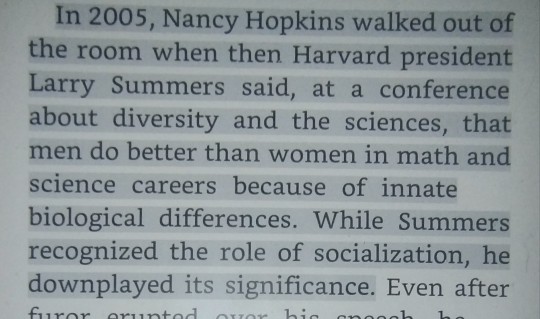
I hate academia wtf
Please professor, tell me how the fact that I have an uterus makes me less capable of being a scientist
#since you got your degree#and know every fucking thing#Harvard#academia#misogyny#sexism#radfem#radical feminism#radfem safe#radblr#radfems do interact#radfems do touch#feminism#women in stem#women in science#female scientists
6 notes
·
View notes
Text
The thing is for me as a woman, admitting that even with regular exercise I'll probably always be physically weaker than most men, doesn't equal saying I'm weak, or that my sex is weak, or that me or my sex are less than or worse than men. Because I'm not a sexist, misogynistic arsehole. Yeah my bones and muscle mass might be inferior - just like a spider is smaller than a human. But some snake's poisons will kill an adult man in seconds, and in the same way, I will bloody hurt a man if I have to, because I've got more brains, more heart, and more ovaries than any of them. Acknowledging science doesn't mean women are the weaker ones any more than acknowledging gravity doesn't mean humans can't ever step on the moon.
4 notes
·
View notes
Text
As much as I enjoy unethical (pseudo)science in fiction, in real life killing them with my mind is not enough I need to strangle these people with my own two hands.
Your methodology is bad and you should feel bad.
#part of the reason is that#unethical science with questionable methodology in fiction is primarily about#doc brown or herbert west types creating cool shit like perpetual motion machines or radioactive mutant zombie sharks or whatever#but in real life it's invariably either#1. a case of ''we attempted to justify our racism/sexism/bigotry with paper-thin ''evidence'' that don't stack up to the slightest scrutiny'#2. straight-up plagiarism/research theft or a case of fabricated and/or falsified data#or 3. literal actual war crimes#mmari rambles#mad science aesthetic#feral science aesthetic#mmari's adventures in academia
4 notes
·
View notes
Text
By: Lawrence M. Krauss
Published: Sep 11, 2023
The voyage of discovery that science offers can take us furthest when it is open to the best and brightest, regardless of who they are and where they come from. Great scientific minds often emerge from unexpected backgrounds. Many scientific disciplines remained effectively closed to ethnic minorities and to women for far too long. But over the past 50 years at least, science has opened up and a host of affirmative action programs have been created to encourage women and minorities to consider careers in the field.
For some activists, however, these efforts have not gone far enough. In response, universities, industries, and research institutions have instituted a vast bureaucracy designed to promote Diversity, Equity, and Inclusion: a behemoth that is growing at a rate far exceeding that of investment in new faculty and facilities.
This has resulted in some disturbing new trends in academia and scientific institutions more broadly. In a desire to include women and minorities, white males are often excluded, and too often women and members of minority groups are tokenized by being promoted primarily for their gender or skin color.
This tokenism has affected the most prestigious institutions. It was a bone of a contention at this year’s Lindau Nobel Laureate meeting. Citing fellow laureate Christiane Nüsslein-Volhard, who has questioned the use of gender quotas in STEM and warned against “discrimination against men,” Nobel prizewinner Kurt Wüthrich commented that he felt discriminated against “in the climate that this meeting is being held.” He was particularly dismayed by the fact that the female laureates were placed in the front row of a group photo—an example, he felt, of insulting tokenism. “I would feel horrible if presented in this way,” he said. “It was ridiculous, fully ridiculous.” As a result of voicing these views, Wüthrich was accused of violating the meeting’s code of conduct.
That may have been a minor issue of optics, but his more general point is valid. Look at almost any online photo promoting science and you will find this kind of tokenism.
Here are several examples.
The first is from a recent article in Science, the official journal of the American Association for the Advancement of Science.

[ Source: Science. ]
Scientific societies should encourage all young people to consider a career in scientific discovery. Science nevertheless seems to feel the need to present a patronizing advertising image, featuring three women and two men of color.
In an email encouraging young people to embark on scientific careers, the American Physical Society presents an image of five women and a black man. The omissions—presumably done in the name of diversity—are obvious and embarrassing.

[ Source: Substack. ]
In advertisements for their annual general meeting, which attracts over 10,000 scientists from all over the world, the APS shows three women and one male of color.

[ Source: APS website ]
For hundreds of years, white men in lab coats were presented as the face of science. It is time to change that picture. But we should do without losing touch with reality or becoming overtly patronizing.
This trend of prioritizing women and minorities is not restricted to advertising and public relations but is affecting faculty appointments at every level.
Let’s start at the top. Six of the eight Ivy League universities—Harvard, Brown, Penn, Cornell, Dartmouth, and Columbia—now have female presidents, as do UC Berkeley and MIT.
MIT is a particularly striking case. Despite comprising many traditionally male-dominated STEM disciplines, its upper management team is largely female. The head of the MIT Corporation, the President, the Director of Research, the Provost, the Chancellor, and the Dean of Science are all women. The Institute’s core discipline, the School of Engineering, consists of eight departments, five of which are led by women. This is clearly not a coincidence, nor is it likely, given the demographics of the place, that this is simply the result of choosing the best people for those jobs. Were the situation reversed—if most of the faculty were female, but the leading administrators were all male—there would be an outcry.
It is still the case that most full professors, in most STEM disciplines, are male. But the reasons for this are often misunderstood. It generally takes decades to attain this rank, and many full professors have been in their current positions for over 30 years. Even if the hiring system were now biased in favor of women, they would not yet have achieved parity at the senior level.
And the hiring system may well be biased. Thanks to the Diversity, Equity, and Inclusion infrastructure that dominates almost every major US university today, affirmative action initiatives have affected the hiring of junior faculty across the board.
It is difficult to obtain national statistics on this, but in 2015, before DEI initiatives reached current heights, a study published in the Proceedings of the National Academy of Sciences revealed a two to one preference for female candidates for tenure track positions in STEM.
New faculty announcements suggest a similar bias. For example, in 2021, UCLA announced the following new appointments in the physical sciences: Abigail Doyle (Chemistry and Biochemistry), Alvine Kamaha (Physics and Astronomy), Courtney Shelly (Statistics/Mathematics), Qianhui Shi (Physics and Astronomy), and Hong Wang (Mathematics). It did not appoint any new male faculty. Similar examples abound.
We can detect comparable trends further up the tenure ladder, too. For example, MIT has just announced the election of six new Fellows to the American Physical Society. This represents a significant career milestone for the successful candidates. I was happy to see that they include my well-deserving former graduate student, Hong Liu, but that aside, the trend seems clear.
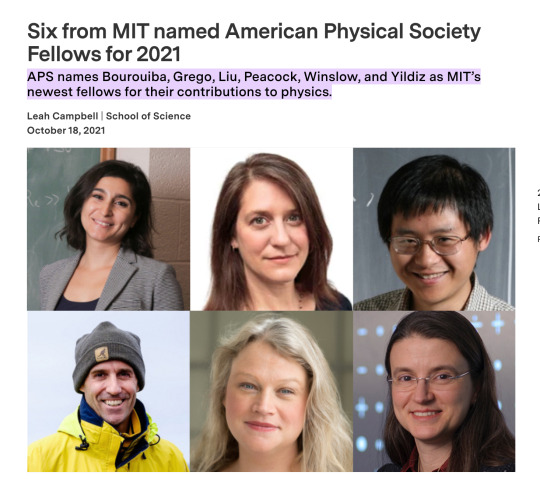
[ Source: MIT News ]
Affirmative action is not the only explanation for the increasing paucity of white males in such positions. The American Physical Society offers a plethora of programs designed to assist pre-tenure female (and sometimes male minority) faculty in physics. There are conferences, leadership programs, internships, grants, workshops, networks, site visits, guidelines, scholarships, fellowships, and prizes. There are no similar programs for young white male scientists, although many of them face similar career challenges.
In US academia in general, women now receive more doctoral degrees than men.
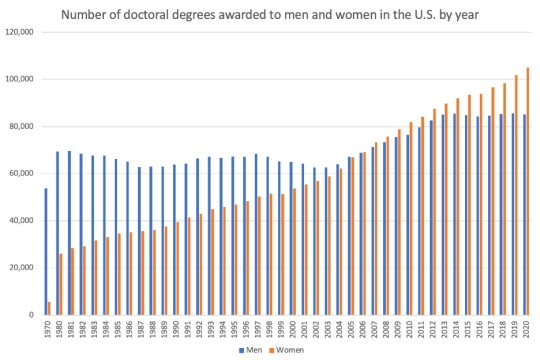
[ Source: Cory Clark and Bo Winegard for Quillette ]
Women also occupy most faculty positions in post-secondary institutions.
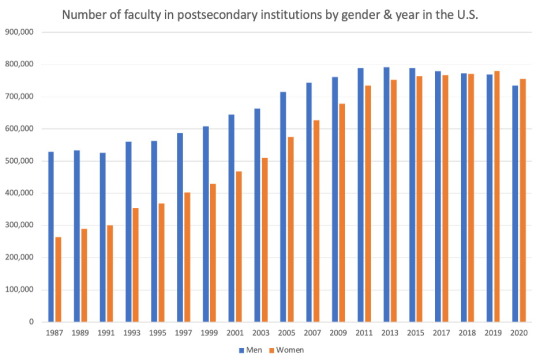
[ Source: Cory Clark and Bo Winegard for Quillette ]
While it is heartening that the climate for women in academia has been improving, these figures suggest that the laser focus on recruiting, retaining, spotlighting, and promoting women in STEM may have become superfluous.
As April Bleske-Rechek and Michael Bernstein have shown, while men still occupy three quarters of STEM positions (despite the fact that the percentage of women in STEM has more than doubled since 1980), the situation is precisely reversed in the fields of health, education, administration, and literacy. While massive efforts are underway to correct the imbalance between men and women in STEM, there have been no concomitant efforts to increase the numbers of men in female-dominated professions. People do not seem to perceive the latter imbalance as a problem. In a recent survey of over 800 recent college students, Bleske-Rechek and Bernstein found that the students were overwhelmingly more concerned about male overrepresentation in certain high status professional positions than about female overrepresentation in others.
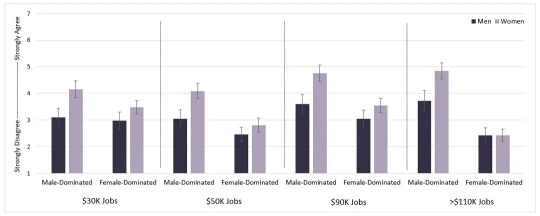
[ Responses to the question "Do you agree that the gender gap is problematic?" Source: Unsafe Science. ]
This was the case even though the female-dominated disciplines were not considered lower status than the male-dominated ones.

[ Responses to the question "Do you agree that the job is high in status?" Source: Unsafe Science. ]
Other data in the study suggest that gender gaps in male-dominated disciplines are significantly more likely to be attributed to sexism or discrimination than they are in female-dominated disciplines.
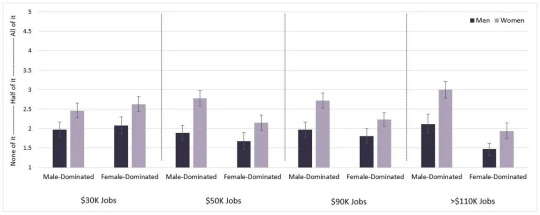
[ Responses to the question “How much of the gender gap is due to sexism/discrimination?” Source: Unsafe Science ]
These results align with recent work by Matt Grawitch et al., summarized here. Grawitch and his colleagues found that both male and female respondents were more likely to judge that an interaction between a banker and a client had been sexist when the banker was male and the client female than the reverse. We are far more likely to attribute sexism to disparities that favor men than disparities that favor women.
The impression that universities are primarily concerned with hiring, supporting, and promoting women may be contributing to the fact that, at entry levels, young men are leaving higher education in their droves.
We can see the results of this in the California State universities: the undergraduate student body at Cal State Los Angeles is 59 percent female, and 67 percent of its graduate students are female; Sonoma State is 63 percent female; San Diego State is 57 percent female; Humboldt State is 58 percent female; Cal State East Bay is 61 percent female. Nationwide, around 60 percent of students are female. And the gender gap is growing. Recent data show a significant downward trend in male college enrollments, which has coincided with the increasing prevalence of DEI programs.

[ Source: Brookings Institution ]
The reduction in male undergraduate numbers is partly caused by the fact that young women are graduating from high school in higher numbers than their male counterparts. In fact, women now graduate at higher rates than men at all educational levels.

[ Source: Brookings Institution ]
Similar trends are emerging at pre-university level. Consider this announcement of the finalists and winners of the 3M Young Scientist Challenge.
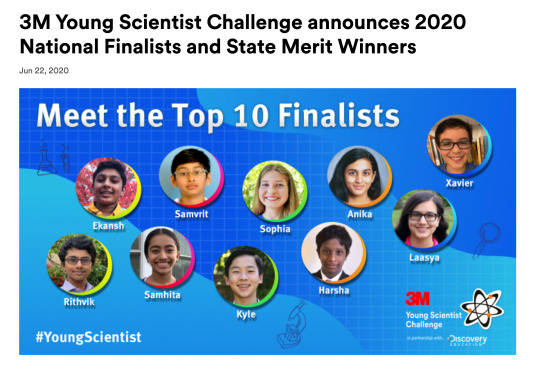
[ Source: 3M News Center ]
It is no surprise to see a high prevalence of Indian and Chinese students among this group, as East and South Asians have been outperforming white students for some time. What is perhaps more surprising is that the finalists included only one young Caucasian male.
Perhaps this is partly due to way such programs recruit applicants. Consider this advertisement for the Regeneron Science Talent Search.

[ Source: Society for Science ]
Is the nearly complete absence of white males in these images the result of a decision to highlight women and minorities—or are fewer white men getting involved in such programs than ever before?
We may be moving towards a future in which women will be significantly better educated than men and will occupy far more of the jobs that require professional qualifications and skills. The societal impacts of this are unknown.
We must continue to ensure that higher education and scientific training remain open to people from all demographics. But we should not encourage diversity at the cost of driving away talented people. Our fixation on raising the profile of women and minorities in science by minimizing the role and status of men in general, and white men in particular, is misplaced.
After more than 40 years of intense affirmative action efforts, it may be time to take our thumbs off the scale and let a natural balance emerge. Young males—and white males in particular—should not be discouraged from pursuing higher education in science, or from engaging in any other field of intellectual activity.
[ Via: https://archive.md/18k9n ]
==
DEI does not belong in science.
#Lawrence M. Krauss#science#diversity equity and inclusion#diversity#equity#inclusion#affirmative action#diversity hire#sexism#anti male#anti male bias#sex discrimination#sexism against men
7 notes
·
View notes
Text
my biggest pet peeve is when sci fi media where humans don't have any significant influence in the universe has societal roles specific to humans
#like get creative oh my fucking god#you're literally dealing with an alien species there does not have to be the man/woman binary#you can make a race full of sexless beings#wdym in ur alien species sexism works the same way as humans#what the fuck#sci fi#science fiction
2 notes
·
View notes
Text
In Britain witch-finders, also called 'prickers', were employed, receiving a handsome bounty for each girl or woman they turned over for execution. They had no incentive to be cautious in their accusations. Typically they looked for 'devil's marks' - scars or birthmarks or nevi - that when pricked with a pin neither hurt nor bled. A simple sleight of hand often gave the appearance that the pin penetrated deep into the witch's flesh. When no visible marks were apparent, 'invisible marks' sufficed. Upon the gallows, one mid-seventeenth-century pricker 'confessed he had been the death of above 220 women in England and Scotland, for the gain of twenty shillings apiece'.
In the witch trials, mitigating evidence or defence witnesses were inadmissible. In any case, it was nearly impossible to provide compelling alibis for accused witches: the rules of evidence had a special character. For example, in more than one case a husband attested that his wife was asleep in his arms at the very moment she was accused of frolicking with the devil at a witch's Sabbath; but the archbishop patiently explained that a demon had taken the place of the wife. The husbands were not to imagine that their powers of perception could exceed Satan's powers of deception. The beautiful young women were perforce consigned to the flames.
— The Demon-Haunted World: Science as a Candle in the Dark - Carl Sagan (1996)
#witchcraft#witches#witch trials#persecution#misogny#sexism#The Demon Haunted World#Carl Sagan#Science As A Candle in the Dark#books#book quotes#quotes#science#nonfiction#philosophy#religion#history#skepticism#atheism#agnostic#psychology#atypicalreads#physics#astrology#papa sagan#popular science#pseudoscience#1990s#1996
2 notes
·
View notes